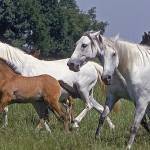Osteochondritis Dissecans in Horses: Frequency in Lusitanos

Osteochondritis dissecans, known to many by the initialism OCD, is a skeletal developmental disorder characterized by cartilage that fails to properly transform to bone. While researchers have investigated the prevalence of OCD in racing breeds, such as Thoroughbreds and Standardbreds, no studies have addressed the condition in Lusitanos, a Portuguese breed known for its willingness, intelligence, and easy-keeper metabolism. A group of researchers in Portugal set out to assess the prevalence of OCD in Lusitano horses and to define the characteristics of the disorder as they pertain specifically to the breed.*
Just over 300 Lusitanos were enrolled in the retrospective study. Most were stallions (268), though mares (15) and geldings (19) were also represented. All horses were between one and 12 years of age, with a mean age of 5 years old. All had been examined radiographically, and joints evaluated included the fore and hind fetlock (metacarpophalangeal and metatarsophalangeal), the intersection of the tibia and hock (tarsocrural), and stifle (femoropatellar). In total, more than 3,000 radiographs were reviewed.
Three veterinarians classified each radiograph using a scale of 0-4 with these descriptions: 0 – normal joint contours; 1 – minimal (smooth flattening); 2 – mild (irregular flattening); 3 – moderate (presence of a small fragment with presence of a small defect); and 4 – severe (large fragment or fragments with a large defect).
How susceptible are Lusitanos to OCD? The researchers observed radiographic evidence of OCD in 53% of the horses examined, though most cases were considered mild or moderate, with scores of 1 or 2. Higher scores—3 or 4—had much lower prevalence, about 17%. As far as specific location of OCD, the most commonly affected joint was the tarsocrural, while the least affected was the femoropatellar.
“Researchers cannot pinpoint the exact cause of OCD, so it is generally considered a multifactorial condition in which genetics, nutrition, exercise, and possibly other influences may all be involved,” said Catherine Whitehouse, M.S., a nutrition advisor at Kentucky Equine Research.
Careful selection of breeding stock coupled with appropriate nutrition of mares, foals, and weanlings are preventive strategies.
According to Whitehouse, nutritional management of young horses should focus on delivering key nutrients in a way that supports slow, steady growth. Providing high-quality forage and a concentrate formulated specifically for growing horses at the rate recommended by the manufacturer is one way to ensure proper nourishment. For young horses that may not need the calories of a concentrate, a well-formulated ration balancer might be more appropriate.
Accelerated growth can cause developmental disease in some horses.“Keeping track of growth rates of young horses on a monthly basis is one way to make sure horses are not growing too quickly,” she said. Growth-tracking software, such as Gro-Trac from Kentucky Equine Research, allows breeders to maintain records on growth with ease.
*Ramos, S., A. Pinto, J. Cresp, J.P. Marques, E. Bettencourt, L.T. Gama, and S. Monteiro. 2022. Osteochondrosis (osteochondritis dissecans) in Lusitano horses: Prevalence and characteristics. Journal of Equine Veterinary Science 117:104063.








